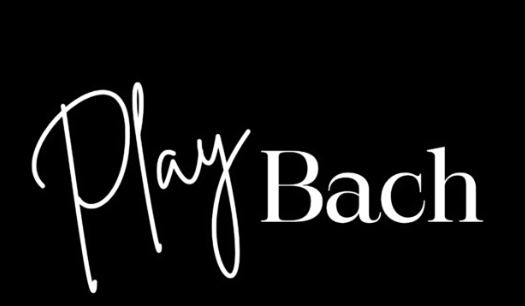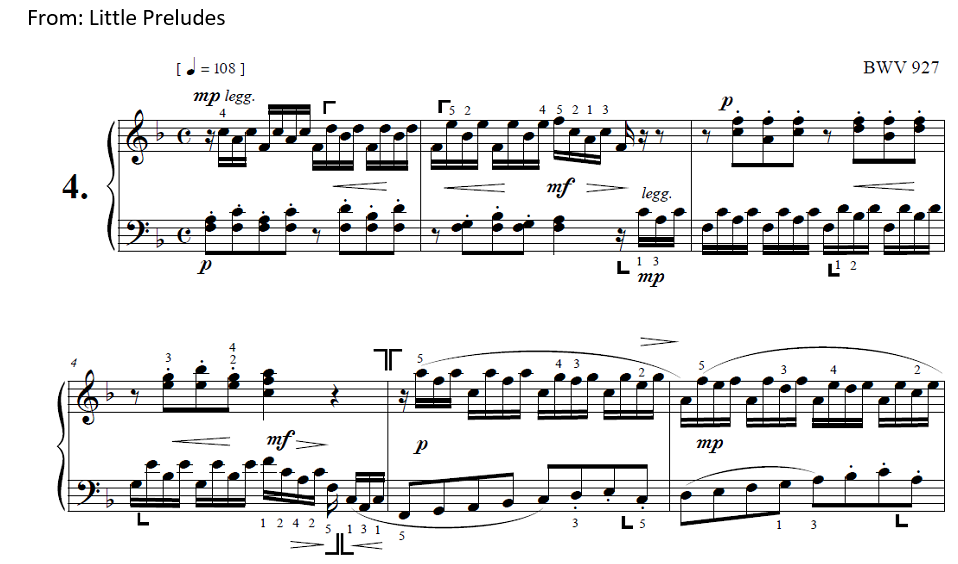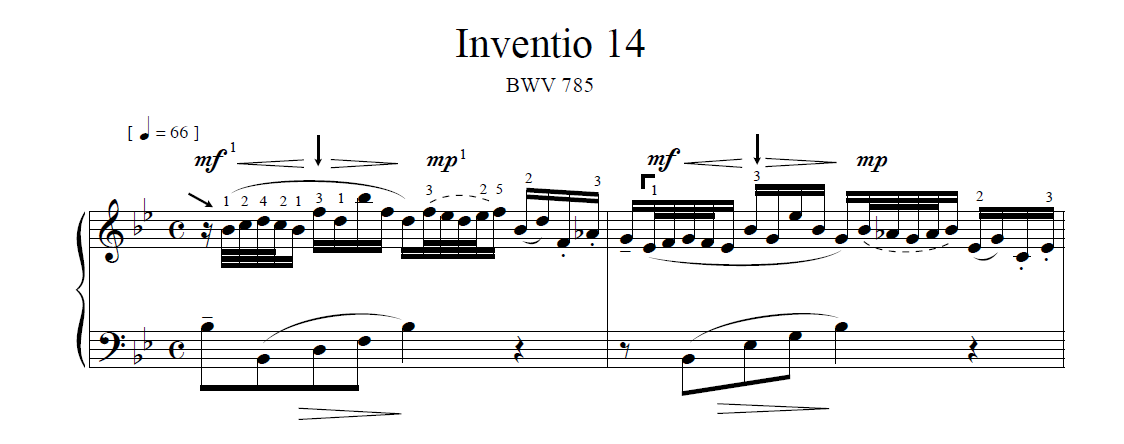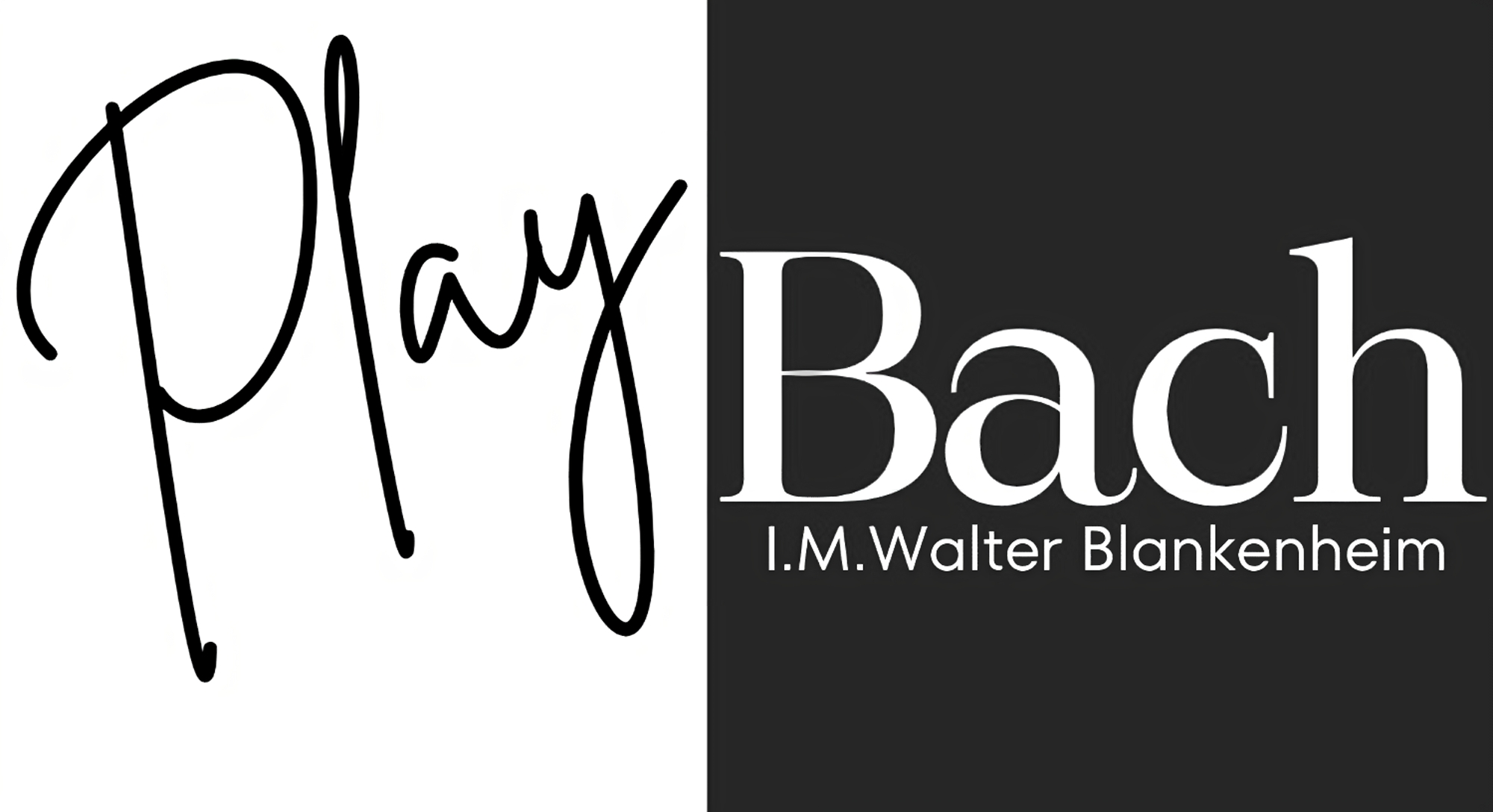We hope that this edition will take some of the hard work out of the process of learning and practicing these works, and more importantly, bring joy and encourage students to become better acquainted with the music of J. S. Bach. May it also give young musicians ideas on how to develop their own interpretations through this interaction with Bach’s works on a creative level.
Kirill Monorosi (Sydney, Australia) and Inge Rosar (Saarbrücken, Germany) March 2021
La Folia © Edition
Canon on the Goldberg Ground
Canon on the Goldberg Ground 1a und 1b – La Folia © Score
Canon on the Goldberg Ground 2a und 2b – La Folia © Score
Canon on the Goldberg Ground 3 und 4 – La Folia © Score
Other Canons
Canon in C major version a, BWV 1075 – La Folia © Score (a and b)
Canon in C major version b, BWV 1075
Notebook for Anna Magdalena Bach
C. Petzold: Menuet G major from the Anna Magdalena Bach Notebook, BWV Anh. 114 La Folia © Score
C. Petzold: Minuet from the Anna Magdalena Bach Notebook, BWV Anh. 115 La Folia © Score
J. S. Bach: Minuet in G major from the Anna Magdalena Bach Notebook, BWV Anh.116 La Folia © Score
C. P. E. Bach: March from the Anna Magdalena Bach Notebook, BWV Anh. 122 La Folia © Score
J. S. Bach: Musette in D major from the Anna Magdalena Bach Notebook, BWV Anh. 126 La Folia © Score
J. S. Bach: Aria from the Anna Magdalena Bach Notebook, BWV Anh. 515 La Folia © Score
Schaff’s mit mir Gott from the Anna Magdalena Bach Notebook, BWV Anh. 514 La Folia © Score
Little Preludes
C minor BWV 924 – La Folia © Score
C major BWV 933 – La Folia © Score
C major BWV 939 – La Folia © Score
G minor BWV 929 – La Folia © Score
D minor BWV 926 – La Folia © Score
F major BWV 927 – La Folia © Score
F major BWV 928 – La Folia © Score
C minor BWV 999 – La Folia © Score
Six Little Preludes BWV 939–943+999 C minor
La Folia © Score
French Suites
Minuet I and Minuet II from the French Suite I in D minor BWV 812
La Folia © Score
Minuet I and Minuet II from the French Suite 2 in C minor BWV 813
La Folia © Score
Minuet and Trio from the French Suite 3 BWV 814 –
La Folia © Score
Inventions
Invention No. 1 in C major BWV 772 – La Folia © Score
Invention No. 3 in D major BWV 774 – La Folia © Score
Invention No. 5 in E-flat major BWV 776 – La Folia © Score
Invention No. 6 in E major BWV 777 – La Folia © Score
Invention No. 7 in E minor BWV 778 – La Folia © Score
Invention No. 8 in F major BWV 779 – La Folia © Score
Invention No. 9 in F minor BWV 780 – La Folia © Score
Invention No. 10 in G major BWV 781 – La Folia © Score
Invention No. 11 in G minor BWV 782 – La Folia © Score
Invention No. 14 in B-flat major BWV785 – La Folia © Score
Invention No. 15 in B minor BWV 786 – La Folia © Score
Sinfonias
No. 5 in E-flat major, BWV 791 – La Folia © Score
No. 11 in G minor, BWV 797 – La Folia © Score
No. 14 in B major, BWV 800 – La Folia © Score
No. 15 in B minor, BWV 801 – La Folia © Score
Chorale
Schaff’s mit mir Gott from the Anna Magdalena Bach Notebook, BWV Anh. 514
La Folia © Score
Gottes Sohn ist kommen, (2-part version) BWV 318
La Folia © Score
Erschienen ist der herrliche Tag, (2-part version) BWV 145/5
La Folia © Score
Jesu, meine Freude, (2-part version) BWV 64/8
La Folia © Score
Liebster Jesu, wir sind hier, (2-part version) BWV 731
La Folia © Score
Nun komm, der Heiden Heiland, (2-part version) BWV 62/6
La Folia © Score
Ich ruf zu Dir, Herr Jesu Christ, (2-part version) BWV 1124
La Folia © Score
In dulci jubilo, (2-part version) BWV 368
La Folia © Score
Single works by J.S. Bach
Fantasia in A minor BWV 922
La Folia © Score
J.S. Bach – A.Siloti
Prelude from the Cello Suite No. 1 – La Folia © Score
Courante from the Cello Suite No. 1 – La Folia © Score
Bourrée I + II from the Cello Suite No. 3 – La Folia © Score
Methode ou Recueil – Andante in A minor No. 21 – La Folia © Score
Methode ou Recueil – Prelude in A minor No. 48 – La Folia © Score
Methode ou Recueil – Toccata No. 68
(sometimes 69. It is called Toccata!) – La Folia © Score
Suite No. 1 in C major Prelude – La Folia © Score
Vite in D major, TWV 33:16/3 – La Folia © Score
Lento TWV 33:9/2 – La Folia © Score
Gigue al’ Anglaise (Der getreue Musik-Meister) – La Folia © Score
Sonata in D minor K. 32 – La Folia © Score
Sonata in D minor K. 90 – La Folia © Score
Sonata in C major K. 95 – La Folia © Score
Chaconne in D major (Theme and Variations) –La Folia © Score
Minuet en Rondeau in C major – La Folia © Score
Andante from the Sonata No. 10 – La Folia © Score
J. W. Hässler
– From: 360 Preludes Op. 4
Prelude 6 in D and Prelude 11 in B-minor – La Folia © Score
Prelude 6 in G major and Prelude 11 in E minor – La Folia © Score
Prelude 11 in F major and Prelude 5 in D minor – La Folia © Score
Preludes 5 in B-flat Major and Prelude 4 in G minor – La Folia © Score
Using this edition
The following is a list of all the parameters that are to be found in the score
(not all of them will be found in each piece):
* Tempo suggestions
* Structure and Phrasing
* Articulation and Note Functions
* Dynamics and Dynamic Shaping
* Ornaments and Figurations
* The use of Pedals
* Fingering and arrangements between hands
……………………………………………………………………
* Structure and Phrasing
In music of the late-Baroque period, and Bach’s works in particular, structure is paramount, and is supported by other parameters such as phrasing, articulation and dynamics.
These indicate an upbeat and the beginning of a new phrase:
![]()
These indicate the beginning of a new section:
![]()
These indicate a thematic entry:
![]()
* Articulations and Note Functions
Although Bach notated articulations in scores and orchestral and vocal parts of his cantatas, passions, and concertos, the lack of notated articulations by Bach in his solo keyboard works is a constant source of frustration for musicians, with the sheer amount of logical possibilities often acting as a block to performers. When articulations are notated, they are often not precise (as can be seen by taking a glance at the beginnings and endings of slurs in example 4), and can be contradictory. To make matters even more confusing, articulations that are suitable for a clavichord or harpsichord, may not be suitable to the modern piano. For those reasons, some of the articulations suggested in this edition differ to the few articulations in the autograph score of the inventions. The guiding principle for the choice of articulation in this edition was the understanding of the different functions of notes, depending on their position in the context of a piece.
* Fingering and arrangements between hands
To help the less experienced pianists with the technical execution of these works, we have added fingerings that combine the “strong” fingers (1, 2, 3) with the “weak” fingers (4, 5) in a way that allows a flexible, relaxed way of playing. C. P. E. Bach in his didactic keyboard works, and in particular in his Essay on the True Art of Playing Keyboard Instruments makes clear the importance of a good fingering: “… an average performer with well-trained fingers will best the greatest musician who because of poor fingering is forced to play, against his better judgement.”
* Dynamics and Dynamic Shaping
Dynamics can be understood as structural (Terraced Dynamics) and as dynamic shaping within the individual step of the ‘terrace’. Playing on a dynamically flexible instrument such as the modern piano, allows the performer to not only use terraced dynamics to clearly separate sections by designating a main dyamic per section (e.g. f, mf, p), but also to support the musical content of these sections with dynamic shaping, resulting in what Walter Blankenheim called a ‘living’ or ‘animated’ line. To notate a finer gradation in dynamics more precisely, this edition makes use of numbered indications (P1, p2, p3, mf, mf etc.).
The upbeat (one or more notes) has a sense of energy and direction, and therefore needs to be supported with a crescendo. The culmination is the goal towards which the music has been building up. The end of a phrase brings a relaxation, and therefore needs to be supported with a decrescendo. Culminations are marked in this edition with arrows (the direction depending on the voice and position on the stave).

Dynamic indications such as p or mf, and dynamic processes (crescendo, decrescendo), as well as structural sings and arrows indicating the entries of themes or subjects are indicated only in the first structural section in this edition, and have to be added according to the introduced ideas in subsequent sections by the performer.
* Ornaments and Figurations
Bach’s own table of the ornaments—as set out by him in the Clavier-Büchlein vor Wilhelm Friedemann Bach—provides an invaluable guide to the interpretation of his ornaments, and is readily available in a number of sources. However, not every ornament should be unquestionably interpreted following the guide and the established rules (such as beginning trills with the upper note), as in certain situations doing so leads to parallel fifths or octaves.
A difference between trills that begin with the upper and main note is made clear through fingering indications. For further clarity, the number of notes that can be played in short trills is indicated for convenience where required.
We hope that this edition will take some of the hard work out of the process of learning and practicing these works, and more importantly, bring joy and encourage students to become better acquainted with the music of J. S. Bach. May it also give young musicians ideas on how to develop their own interpretations through this interaction with Bach’s works on a creative level.
Kirill Monorosi (Sydney, Australia) and Inge Rosar (Saarbrücken, Germany) March 2021








